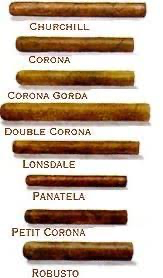Size Does Not Matter….. but Quality Does!
You might have seen it in the movies, or in TV shows, or smelled the aroma from your neighbors backyard. Someone is sporting a large cigar, and is smoking it unaffectedly. They seem to like it, that tight, large wad of smoke and leaves. But what makes cigars so prized, and why is it often associated with wealth and business?
Very simply, a cigar is a rolled-up heap of dried, fermented tobacco. One end is lit with fire, and the other is the opening by which smoke can enter a user’s mouth. Cigar tobacco is considered special: its flavor is richer and deeper than the tobacco that is used for an ordinary cigarette. Most cigar tobacco is grown in tropical countries, with Brazil, Cuba, Honduras, Nicaragua and the Dominican Republic leading the pack. Cuban cigars, in particular, are considered to be the best varieties, although experts contend that Nicaraguan and Honduran cigars easily rival the mighty Cuban and in recent years the Dominican Republic cigars have risen greatly in quality and prominence.
Cigars were once extremely expensive, and were usually confined to special events where “smokers” were held. Basically Cigar Aficionados would come together to smoke and solve the problems of the day or to simply just to Puff, Sip, Chat. In mid-2005, however, cigar prices declined, allowing many smokers (and smoking beginners) to taste and enjoy cigar smoking. This happened to coincide with the explosion of Cigar Lounges across the US. But why cigars? I personally have never been a smoker. I literally may have smoked a single cigarette my entire life. I just never got it or liked it much. But there’s something about the fact that cigars are not a daily occurrence for most of us and actually often take the taste of whiskey, wine or even chocolate!. They do not contain the high, smoky taste of cigarettes.
How are cigars made? Here’s my very oversimplified view of the process (and remember, I like to keep things easy):
- Pick the best Leaves – The choice tobacco leaves are first harvested
- Dry/Age – combination of heat and shade to lower the water and sugar content
- Fermentation – Once the dried leaves are ready, the humidity levels and temperature are controlled, such that the leaves will ferment without disintegrating or rotting. This is where the flavors and aroma are created that characterize the cigar it will eventually become.
- Sort it Out – Leaves are sorted out based on whether they will be used as filler or as wrapper.
- Roll it Up – As soon as they are sorted, they are rolled into any of the various cigar shapes, carefully, and by often by hand although with today’s technology, some makers have done an excellent job of creating a great machine rolled cigar.
- The Cigar is Born – The flavor of a cigar depends on the leaves used for its wrapper and filler.
- Keep Your Cigar Safe – To keep their flavor and quality, cigars should be stored at room temperature, but at relatively high humidity. Getting a humidor for your cigars is the best option but a small travel cigar case as your “starter” kit is what I would recommend at a minimum.
Cigar Types, Shapes and Sizes
Parejos – Cigars that are “Straight-Sided”
They generally have an open “foot” for lighting and a closed, rounded “head” that is cut before smoking. Generally referred to as “Coronas”; they are the traditional size that all other cigar formats are most commonly compared to:
- Petit Corona: This short corona is usually only 4/2″, with a ring gauge 49 to 42
- Corona: The traditional dimensions are 5/2″ to 6″, with a ring gauge of 42 to 44
- Churchill: A large corona format with a strong full-bodied flavors; the traditional dimensions are 7″, with a ring gauge of 48
- Robusto: A short Churchill format with a traditional size of 5″ to 51/2 and about a 50 ring gauge
- Corona Gorda: This long robusto format could be called a robusto extra, although its popularity preceded that of robustos; the traditional measurements are 5, ⅝”, with a ring gauge of 46
- Double Corona: The standard dimensions are 7/2″ to 8″, with a ring gauge of 49 to 52
- Panetela: Shaped like a longer, thinner corona, panetelas were more popular in years past than they are today; this format varies in length from 5” to 7,½”, with a ring gauge of 34 to 38
- Lonsdale: A Lonsdale is generally thicker than a panetela, but longer than a typical corona; the classic size is 6,½”, with a ring gauge of 42 to 44
Figurados
Although most cigars are straight-sided cylinders with one rounded end, there are a number of traditional cigar formats with more novel shapes – the figurados
- Pyramid: A sharply tapered and closed-headed cigar with a wider open foot; these cigars are between 6″ and 7″, with a ring gauge of around 40 at the head that widens to 52 to 54 at the foot
- Belicoso: Traditionally, a short pyramid, 5″ or 5/2″ in length with a shorter, more rounded taper at the head and a ring gauge generally of 50 or less
- Torpedo: A torpedo has a closed foot, a pointed head and a bulge in the middle
- Perfecto: The perfecto has a closed foot and a bulge in the middle; perfectos can vary in the middle; Perfectos can vary greatly in length, from 4/2″ to 9″, with ring gauges between 38 and 48
- Culebra: This shape is made up of three panetelas braided together and banded as one cigar called “ropes”; the three parts are unbraided and smoked separately; usually 5″ to 6″ in length, with a 38-ring gauge
- Diademas: A big cigar -8 or longer, the head is closed and tapered, with a ring gauge of 40, while the foot, which can be open, or closed like a perfecto, is a hefty S2-ring gauge, or larger
Now congratulations! You know WAY too much about cigars! Go impress someone and create another StickMan or StickWoman! There’s power in numbers.
Most importantly, even with all of your newfound knowledge,,, remember that cigar smoking is about relaxation with good people with one single purpose…to Puff, Sip, Chat and Repeat!
Go subscribe to our YouTube Channel
Follow us on Instagram, Facebook and Twitter!








